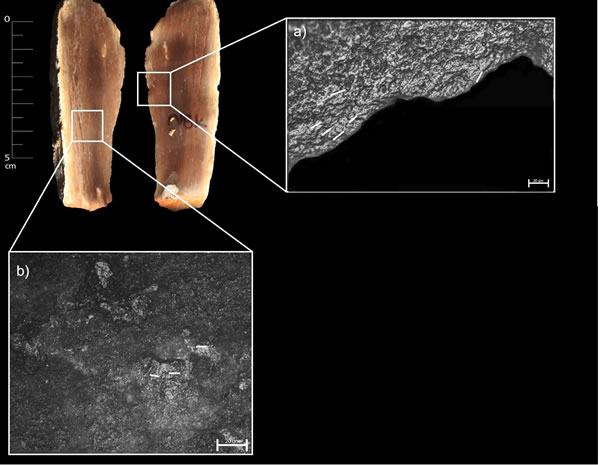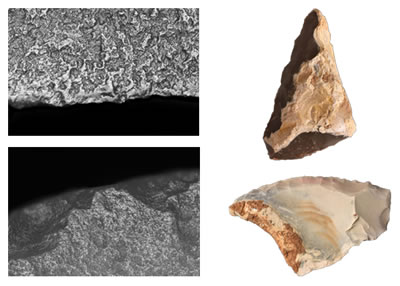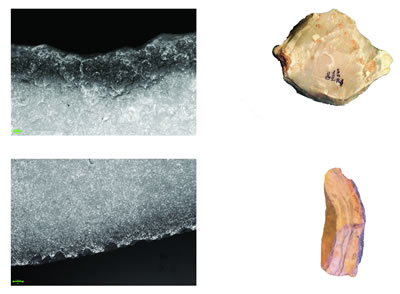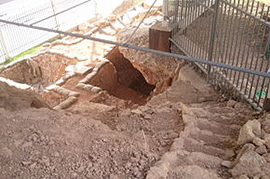Qesem Cave (AYCC), Revadim, Jaljulia (Acheulean)
Site excavation director: A.Gopher, R.Barkai, Department of Archaeology, Tel Aviv University TAU
LTFAPA project Chipped stone tools use-wear and residues analysis funded by MAECI and by International Agreement Project of Speinza University
Qesem Cave and the open sites of Revadim and Jajiulia are located near Tel Aviv. Revadim and Jajiulia are two Late Acheulean sites reach in flint industry characterized by bifaces and by flakes, small flakes, tools, and small tools. At Revadim, the taphonomic processes allowed to preserve numerous remains of fauna that comprise mammals of different sizes and megafuana. Both sites are really promising for the analysis of use-wear and residues. As far as Revadim concerns, various publication documented the use of the lithic industry to carry out different types of activities among which butchering seems to prevail.
The intriguing question under study is if the items of small size, that are abundant at Revadim, may have been involved in the processing of megafauna. To explore the relationship small tools-megafauna a PhD project by TAU with the collaboration with LTFAPA Sapienza (PhD candidate F.Marinelli) is in progress and is starting to produce interesting results now under in publication. Qesem Cave is an extraordinary well-preserved site, consisting of sediments some 10m deep, all assigned to the Acheulo Yabrudian Cultural Complex (AYCC). The flint industry is blade-dominated in the Amudian sequence while scraper-dominated in the Yabrudian sequence. Many burnt bones and flint items were found at Qesem Cave. In addition, ash was found in the cave’s sediments. It appears that the use of fire was common throughout the sequence, including a repeatedly used, superimposed central hearth dated to ca. 300 ka.

The faunal assemblage includes Dama mesopotamica (dominates the assemblage), Bos, Equus, Sus, Testudo, Cervus. The absence of all body parts indicates that carcasses were first processed outside of the site and only selected parts were brought to the cave. Furthermore, cut marks were abundant indicating butchering on-site. Use-wear and residues analyses reviled that at Qesem Cave hominins used blades, Quina and demi-Quina scrapers and small items from recycling to process animal and plant materials. There is no doubt that these categories of tools were used as specialized tools-kit during butchering. In particular, Quina scrapers were used as specialized toolkit to process fresh, semi-dry and dried hide. New extraordinary data, published in 2019 and 2020, documented: 1 – the use of recycled old spheroids macro-lithic tools for the breakage of bones, probably to exploit their marrow, 2 – a complex behaviour of manipulation of animal and plant (tubers) food consisting in roasting with hot wooden ash and/or also preserving food and non-food matters using cold ash.


References
C.Lemorini, M.C.Stiner, A.Gopher, R.Shmelmitz, R.Barkai (2006), Use-wear analysis of an Amudian laminar assemblage from the Acheuleo-Yabrudian of Qesem Cave, Israel, Journal of Archaeological Science 33: 921-934. https://doi..org/10.1016/j.jas.2005.10.019
Shahack-Gross R., Berna F., Karkanas P., Lemorini C., Gopher A., Barkai R. (2014), Evidence for the repeated use of a central hearth at Middle Pleistocene (300 ky ago) Qesem Cave, Israel, Journal of Archaeological Science 44, pp. 12-21, doi:10.1016/j.jas.2013.11.015
N., Solodenko; A., Zupancich; S., Nunziante Cesaro; O., Marder; Lemorini, Cristina; R., Barkai 2015. Fat Residue and Use-Wear Found on Acheulian Biface and Scraper Associated with Butchered Elephant Remains at the Site of Revadim, Israel. pp.1-17. PlosOne. doi:10.1371/journal.pone.0118572
Lemorini C., Venditti F., Assaf E., Parush Y., Barkai R., Gopher A. (2015), The function of recycled lithic items at late Lower Paleolithic QesemCave, Israel: An overview of the use-wear data, Quaternary International 361, pp. 103-112, doi:10.1016/j.quaint.2014.07.032
Barkai R., Lemorini C., Vaquero M. (2015), The origins of recycling: a Paleolithic perspective, Quaternary International 361, pp. 1-3, doi:10.1016/j.quaint.2014.12.044
Lemorini C., Bourguignon L., Zupancich1 A., Gopher A., Barkai R. (2016), A scraper’s life history: Morpho-techno-functional and use-wear analysis of Quina and demi-Quina scrapers from Qesem Cave, Israel, Quaternary International 398, pp. 86-93, doi:10.1016/j.quaint.2015.05.013
Zupancich A., Lemorini C., Gopher A., Barkai R. (2016), On Quina and demi-Quina scraper handling: Preliminary results from the late Lower Paleolithic site of Qesem Cave, Israel, Quaternary International 398, pp. 94-102, doi:10.1016/j.quaint.2015.10.101
Zupancich A., Nunziante-Cesaro S., Blasco R., Rosell J., Cristiani E., Venditti F., Lemorini C., Barkai R. Gopher A. 2016 Early evidence of stone tool use in bone working activities at Qesem Cave, Israel, Scientific Reports 6. http//doi:10.1038/srep37686.
Venditti F., Cristiani E., Nunziante-Cesaro3 S. Agam A., Lemorini C., Barkai R. 2019 Animal residues found on tiny Lower paleolithic tools reveal their use in butchery, Scientific Reports. https://doi.org/10.1038/s41598-019-49650-8
Assaf E, Caricola I, Gopher A, Rosell J, Blasco R, Bar O, Zilberman, E., Lemorini, C., et al. (2020) Shaped stone balls were used for bone marrow extraction at Lower Paleolithic Qesem Cave, Israel. PLoS ONE 15(4): e0230972. https://doi.org/10.1371/journal.pone.0230972
Lemorini C., Cristiani E., Nunziante Cesaro S., Venditti F., Zupancich A., Gopher A. The use of ash at Late Lower Paleolithic Qesem Cave, Israel—An integrated study of use-wear and residue analysis, PlosOne (2020). https://doi.org/10.1371/journal.pone.0237502
Mathias, C.; Lemorini, C.; Marinelli, F.; Sanchez-Dehesa Galan, S.; Shemer, M.; Barkai, R.. (2023 Bulb retouchers half a million years ago: New evidence from late Acheulean Jaljulia, Israel, JOURNAL OF ARCHAEOLOGICAL SCIENCE: REPORTS. – ISSN 2352-409X. – 47:(2023), p. 103821. [10.1016/j.jasrep.2022.103821]


